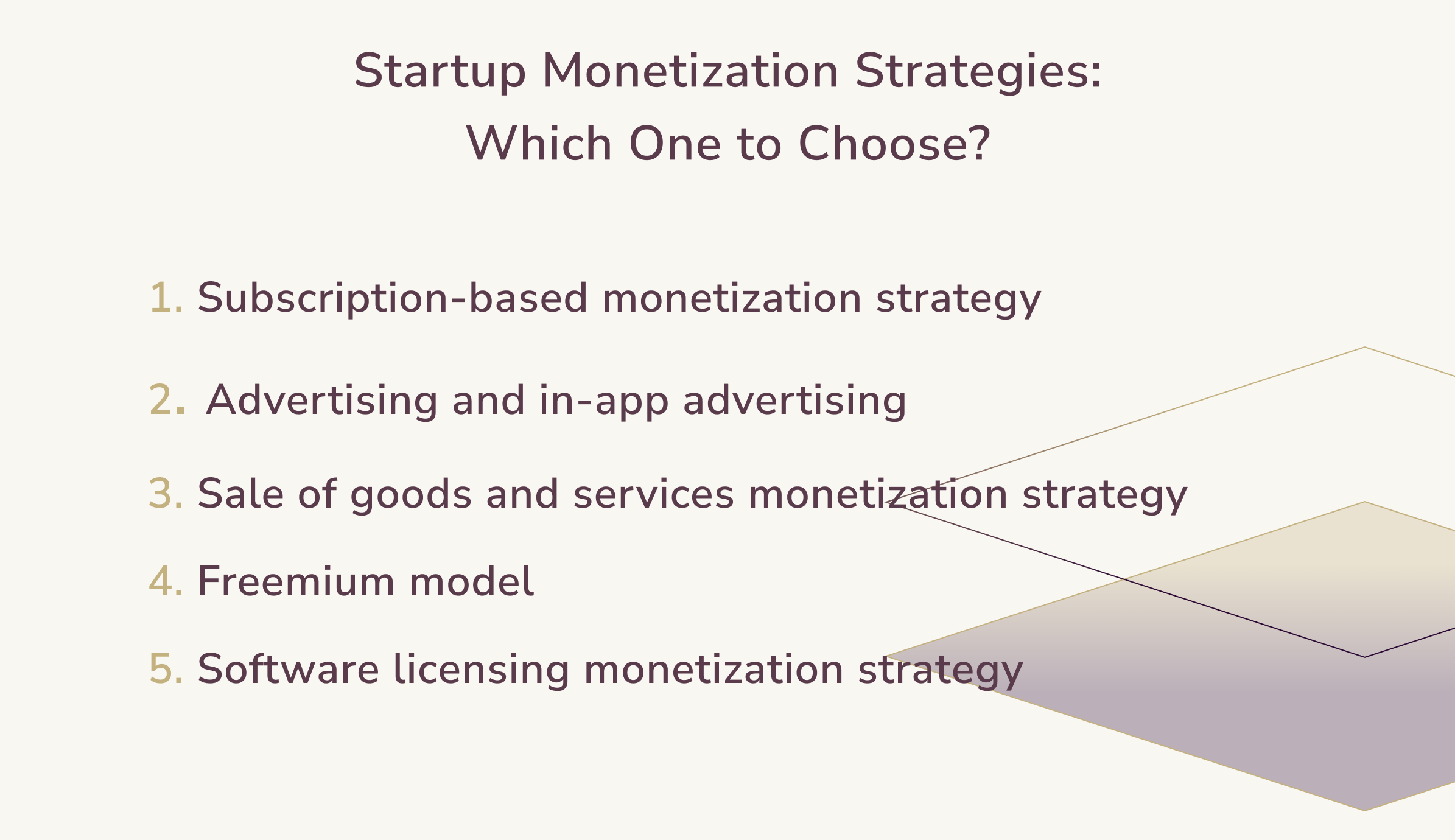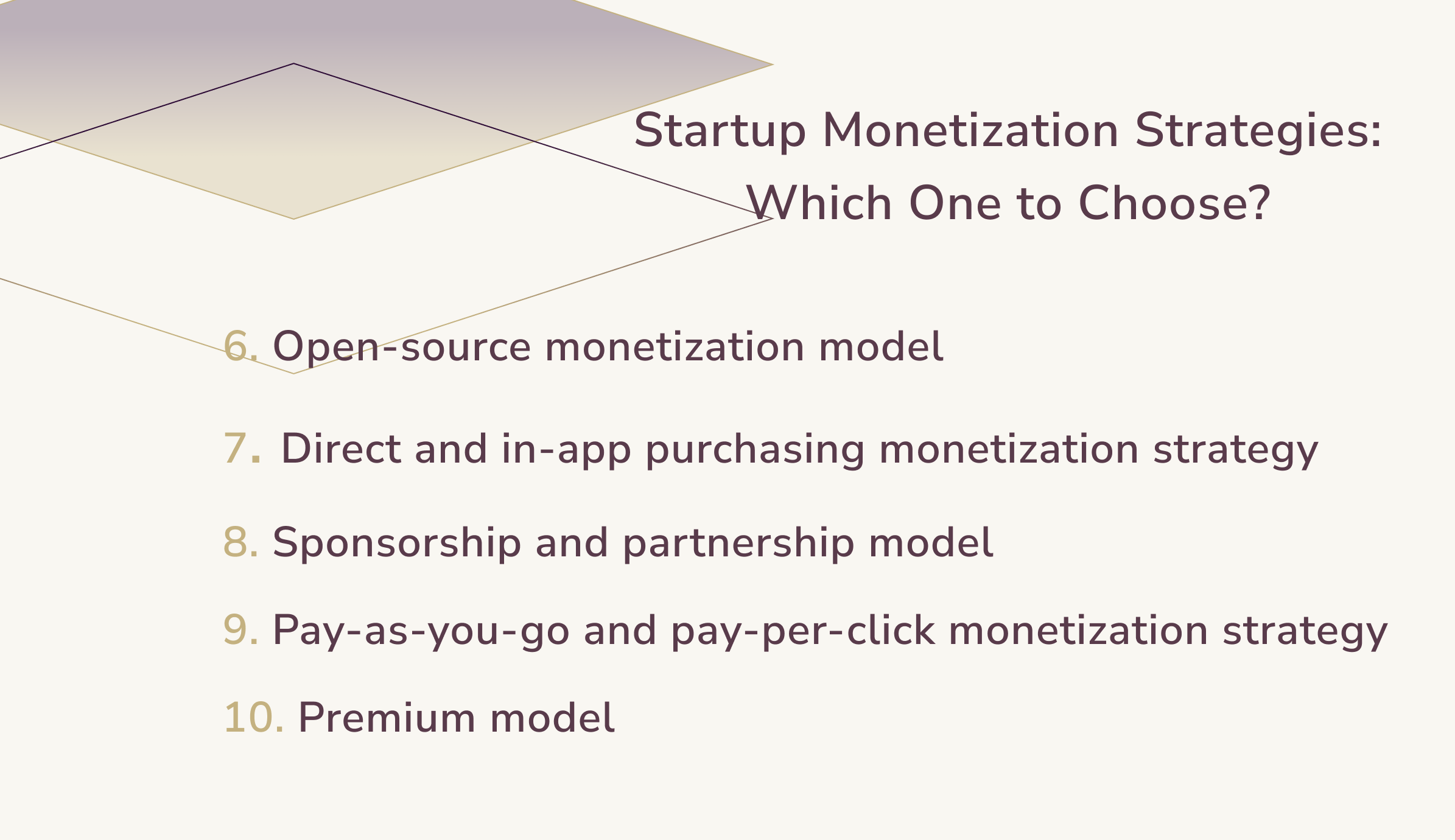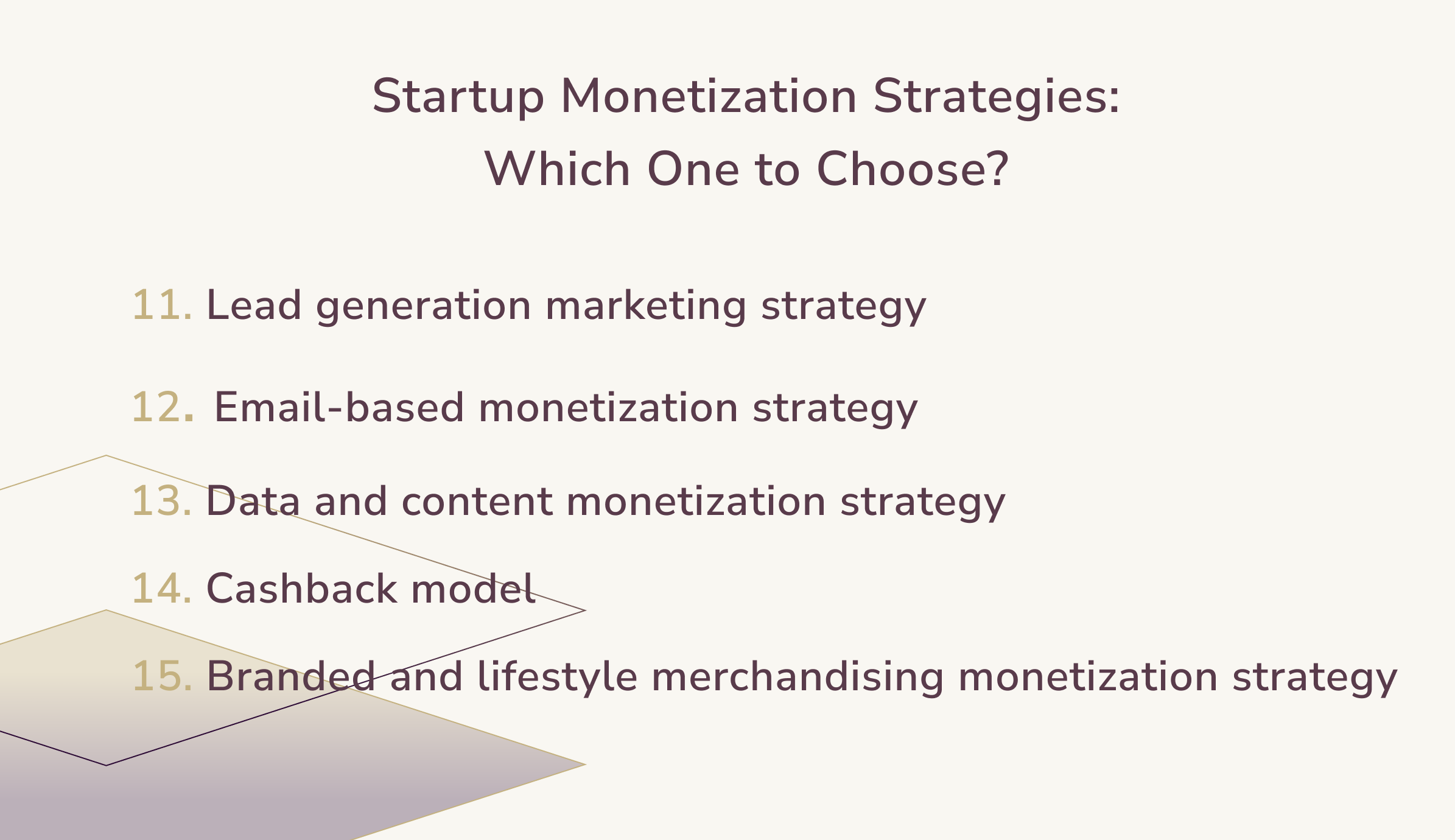Startup Monetization Strategies: A Quick Guide

The evidence points out that about 90% of all startups fail after their inception. It means that only 10% of companies manage to grow and root themselves into a market. Importantly, staying competitive is vital because the global software market is booming. Statista indicates the current market’s value is about $593 billion and is expected to reach $812 in just five years in 2027. So, how can startups stay afloat and get a piece of the pie? Proper monetization strategies are the major part of the answer.
What is a monetization strategy? How to monetize a startup? When should you monetize a startup? These are the questions we will explore further. Besides, we will discover 15 effective startup monetization strategies while also pointing out on most common mistakes made in the process. In a nutshell, a monetization strategy generates revenue through factors like platform, content, or audience. Choosing between them means a difference between failing or succeeding in your revenue streams. Without further ado, let’s investigate more on startup monetization strategies to help you boost your startup to the next level.
15 Startup Monetization Strategies
How to monetize your business? Generally, there are many approaches to choose from. However, each must be implemented to a particular business model and fit certain market criteria. Yet, there are some best monetization strategies that, in most cases, can be applied universally and are proven to work out for the majority of startups. These app monetization strategies are worth your attention:

Subscription-based monetization strategy
As you might have noticed, the list includes content monetization strategies and product monetization strategies alike. In such a case, a subscription-based model is a great starting point. It is an excellent approach for companies operating within business-to-business (B2B) and business-to-client (B2C) monetization strategies.
Subscription-based is the most effective monetization solution for getting revenues from software. You give users access fees at particular time intervals, which can be weekly, monthly, or yearly. Even during the economic downturn brought on by the COVID-19 pandemic, 23% of startups reported accelerated growth due to the subscription-based monetization strategy they used. Regarding the subscription model, some behemoths, like Netflix, have been using it for years. And the monetization strategy works.
Advertising and in-app advertising
How to monetize your online business? Here comes advertising and in-app advertising monetization strategy. Forbes suggests people spend about 1.6 trillion hours using their mobile devices collectively. So, if your startup plans to use custom mobile app development services, an in-app advertising monetization strategy is something you often cannot avoid.
Besides, mobile apps have a higher click-through rate (CTR) than desktop apps. With mobile devices, you can target an audience in a natural way without making an ad appear like spam. In addition, you can alter your in-app advertising strategy on the go as user preferences shift. As a B2C monetization strategy, in-app advertising has been there for years. Yet, the most important part is to make the method smooth and don’t look like spam. Impressively, Facebook managed to squeeze $31 billion from this monetization strategy.
Sale of goods and services monetization strategy
If you plan to have a startup operating in the edtech industry, the sale of goods and services monetization strategy is the one to think about. To monetize the online business, you need to know what your clients want. Besides, you need to know how to fulfill those desires. With the edtech industry, it goes without saying that people what to learn something or know something that brings value.
To illustrate, let’s say you own a cryptocurrency platform that helps people to buy, sell, transfer, and store cryptocurrency. Then, the school for people who want to invest in cryptocurrency will be the right base for your main business. Firstly, you will make money as an edtech business. Secondly, you will secure yourself with a constant stream of qualified leads for the cryptocurrency platform.
In addition, you’ve probably noticed that barely all companies are now offering webinars and courses. Such a business model helps increase your company's trust and shows your expertise. As a result, with the monetization strategy of selling goods and services, you have new clients, can build trust, and give consumers what they want.
Freemium model
Another mobile app monetization strategy is the freemium model. Harvard Business Review indicates that while most businesses present about a 5% customer conversion rate, companies that use the freemium model, for instance, Spotify, offer a 43% conversion rate. So, how this model works?
You develop a product and give free partial access for a short period. When it comes to a software market, they are often extremely saturated, which means barriers to purchasing. With freemium app monetization models and strategies, you can surpass these barriers and bring your software closer to users. The key aspect here is encouraging a person to sign in and try your product. If a user likes it, they can later purchase full access or subscribe for longer usage. At this point, a freemium model will give a person a taste of what they can get for a certain price later.
Software licensing monetization strategy
In short, a software licensing strategy is a legal-based instrument managing the entire process of software use and distribution. Often, these models protect from intellectual property damages, especially if your software is built in object or source codes. Respectively, a software licensing monetization strategy exists to safeguard your products against any type of infringement. Besides, in terms of pricing and marketing, software licensing is a great starting point to utilize premium or penetration pricing.
To illustrate how this app monetization strategy work, consider the following example: there is a platform that builds a SaaS’based product for a million users globally. Any company that wants to gain product access must purchase a license. At this point, by implementing software licensing, you make sure that when your product grows, companies will pay for accessing it. Besides, licensing protects your intellectual property.

Open-source monetization model
Another monetization startup approach is directly related to the open-source model. This approach is valuable for developers. Essentially, they can provide access and control of their code to anyone out there. Some major tech companies like MongoDB make about $13 billion in their open-source ecosystems. However, to understand how the monetization strategy works, there are several aspects to consider.
It might sound confusing that open-source software or code might bring money. However, when looking deeper, everything becomes clear. The open-source products are free, as well as they offer certain features end-users can implement. The monetization part starts when the end user is looking for additional support or hosting. Besides, the software might include some additional features. At this point, the open-source monetization strategy resembles the freemium model. You provide users with some free features, and if consumers like them, they can have more for a fee.
Direct and in-app purchasing monetization strategy
This app monetization strategy brings a lot of money. The evidence indicates in-app purchases bring about $380 billion annually. In such a case, direct and in-app purchasing monetization strategy is best when companies develop mobile apps on Android and iOS. With such cross-platform app development, you can cover more areas and drive more revenues. However, you need to understand that in-app advertising can be disruptive for users if it is done incorrectly.
In such a case, to have an effective in-app monetization strategy in place, follow three simple rules. First, notify users in advance that there is in-app purchasing involved. Second, implement push notifications to tell existing users that in-app purchasing will be present. Finally, adopt in-app purchasing along with a custom loyalty model to smoothen their user experience. In such a case, an in-app purchasing monetization strategy, if done correctly, is an excellent way to improve user experience and make certain you get revenue while people using our product get great value.
Sponsorship and partnership model
Sometimes, when you want to build a top-notch software application, and especially if you run a startup with limited resources, you need to partner up with other vendors. You can also find like-minded developers or freelancers willing to work with you on the same product. Combining resources can be a great way to unite resources and build products that often medium-size businesses can build.
Use this monetization strategy to increase the number of clients you have, as well as to increase brand awareness. Besides, partnership and sponsorship models can be used to increase user experience. For example, imagine you are building car-sharing software. To make the product stand out, you need to have some additional features you cannot afford to implement. So, you find a firm that can build these features and partner up with them. As a result, you get a high-quality product that brings more revenue you share with your partner.
Pay-as-you-go and pay-per-click monetization strategy
When it comes to monetization strategy for apps and websites providing a low barrier for user entry, the pay-as-you-go approach is the one to consider. This model comes with flexibility and low commitment. In a nutshell, within the given framework, a user needs to pay a one-time price to gain access to the product and use it for a particular period of time. In such a case, if a user wants to use the product again, they need to make a one-time payment as well.
This monetization strategy is often used to diversify the number of users you have. Some people do not like different models. That is why the pay-as-you-go model is the one for consumers who like more control in the usage of the software, as well as need a more flexible pricing model.
Premium model
If a freemium model is based on providing free features, this model is all about top-quality services from the get-go. If you want to charge higher prices for the best quality products, you need to think about a premium monetization strategy. The method does not consider low pricing for the sake of market penetration. In turn, it revolves around charging a high price upfront to create a perception of your product as a high-quality one.
Premium is one of the best app monetization strategies. As a B2C method, it helps to show your clients that your software is top-notch and worth the high price. To illustrate, think about companies like Rolex. You can purchase a simple wristwatch for about $20. However, if you want the best quality product, you need to pay more. When you hear about Rolex, you automatically know that it will cost you, while the quality will be through the rough as well.

Lead generation marketing strategy
Going further, in lead generation monetization strategy, you promote some other company or product and receive financial incentives for that. All you need is to insert a link inside your app or product. In turn, other companies and developers can use the link to their products with a call to action (CTA). For every CTA working out, your product gets a financial reward or a commission.
Besides, in the context of lead generation, you can capture user data. Namely, it will show what audiences have an interest in the CTA. In this monetization strategy, you also get a commission for capturing data. This B2C approach is great for diversification in your revenue streams. You can use lead generation to present the product within multiple industries and channels. Lead generation is a great website monetization strategy as well as a great mobile app monetization strategy. And it works best for startups.
Email-based monetization strategy
There are currently about 4 billion people using emails. While some might perceive email marketing as outdated, in reality, it is still up and running. Hubpost suggests about 85% of B2B marketers have an email in their marketing and monetization strategies. At this point, with the rise of email marketing software, users get a great chance to send advertisements and promotions and share valuable information on different products.
Email-based monetization strategies are among the best to help users in their journeys. Besides, they are most effective in promoting user engagement. Basically, you offer regular updates on product changes and new product iterations to keep consumers interested and posted. While, probably, an email will become obsolete in the future, it still works as one of the best app monetization strategies. Therefore, it is important to use the model while it has something to offer.
Data and content monetization strategy
It is no secret that data is the most valuable commodity at the moment. When it comes to Big Data and companies operating in this realm, data and content monetization strategy is extremely important for software development. Why? Namely, because the type of data collected by your product needs to be carefully specified in project requirements.
How can one earn money from data and content monetization? Merely, you can match advertising of different services with customers and get a fee for that. For instance, there are credit reporting companies that charge a monthly fee, while other businesses operating in the same industry and offering the same services are free. The second one earns revenues by bringing advertisers and users closer together. You can use your data and content to narrow down the gap between companies producing something and people who will use these goods and services. And it is all done through data.
Cashback model
Among different app monetization models and strategies, this one is a bit specific. It means that you need to operate in a particular market and industry to be able to tap into this monetization strategy. How does it work? In a nutshell, with a cashback model, you refer users to some third-party shopping platforms by using a special coupon. The party purchasing gets a virtual currency refund for each given buy with this coupon.
Basically, buyers generate more coupons and spend less for goods and services compared to people without coupons. Advertisers get more leads and clients. As an intermediary, you get ta commission for each new lead created for an advertiser. Yet, you need to keep in mind that if your app or software has nothing to do with online shopping, it might be difficult to use the cashback monetization strategy.
Branded and lifestyle merchandising monetization strategy
Last but not least, on the list of monetization strategies for apps is branded and/or lifestyle merchandising. Essentially, with this method, you need to offer free access to products or content. You charge a fee separately. However, while doing so, you also market other products. At this point, it is crucial to label the product you promote.
Consider note-taking software like Evernote as an example. Different famous people and different products are advertising the product. Without a doubt, it brings a massive influx of new users for the software. In turn, people and companies advertising it get a fee. It could be said that this particular monetization strategy is not the one many startups can use. However, if you establish your brand and increase brand awareness, branded products are there for you to use as a major monetization approach.
6 Common Startup Monetization Mistakes
Now, with the 15 startup monetization strategies you know, it is time to dig deeper and explore some of the key mistakes a company might make when monetizing its products and services. It is the moment to ask questions like - when to monetize your startup. Besides, there are some additional inquiries to consider. These will help you avoid issues and errors with startup monetization.

Keeping all the insights in mind, these are the following common mistakes companies make when applying monetization strategies:
Wrong monetization strategy
One of the critical mistakes a company can make in an in-app monetization strategy is to wrongly choose and assume a wrong monetization strategy in the first place. When you offer a certain product vision, you must keep several key aspects in mind. For instance, take into account how the product will scale. If you want more features in the mobile app or to boost its UI/UX, the monetization strategy should change and grow accordingly. At this point, you need to know how the product will change and alter the approach.
To form the long-term monetization strategy, analyze user engagement and its growth. You can do it by focusing on user journey improvement, retention of daily active users (DAU) and monthly active users (MAU), and the duration of active sessions. Then, use all this info for your benefit. For instance, the longer user stays in the application, the more advertisements you can show them.
Another mistake that edtech startup founders make is deciding on the wrong monetization model. It’s no surprise that each monetization model is suitable for a particular business.
Let’s review the choice of the wrong monetization strategy as an example. Scribd book readers first started with Freemium to monetize the startup. They offered unlimited access to the reader, who paid $9 monthly. However, Scribd also had a rule: to restrict access to the users who read too much. They thought it could damage the company. As a result, users overwhelmed Scribd with negative reviews, and they lost both customers and reputation.
So, it is crucial for the edtech startup to choose the right monetization model that suits the specifics of the business. In another case, you will ruin your image before you realize the mistake.
Inaccurate ad format
In-app advertising is the monetization strategy that was proven effective by Duolingo and other famous edtech startups. Although it may seem easy to show ads to the users and gain profit the week after the launch, companies often choose the irrelevant ad format.
The frequent problem is the wrong choice of place and time for advertising. There is a difference between showing three ads right after the user enters your app and showing two short adverts after the user completes the task. Analytics in Google Firebase or similar platforms that track the user journey help edtech startups find out where and when to display ads.
Besides, users often delete apps or leave negative reviews because of irrelevant advertising. Will you be happy with the app that shows ads for cigarettes and online casinos to your child? We bet that you’ll be irritated and never recommend anyone to use this app. In other words, edtech startups have to carefully choose the spots and content for showing ads.
Another challenge startups face with ads is a wrong selection of an advertising network. Different marketing and ad networks provide different ad control capabilities, analytics, and traffic quality. A couple of weeks of collaborating with ad networks allows you to understand whether their way to traffic monetization is effective.
Moreover, the majority of edtech startup founders choose the traffic monetization providers based on cost per 1,000 impressions (CPM). Yet, this approach needs to be better. You need to estimate also the fill rate. It shows the ratio of the number of impressions of an advert to the number of requests for its demonstration. On top of this, it is essential to consider which types of ads are displayed and the conditions when they are effective.
Trying to handle monetization strategies yourself
Only Julius Caesar could do several things simultaneously with the same effectiveness. Yet, even this fact is frequently questioned by researchers.
So, the point is: you cannot be an expert in all fields and do all things by yourself simultaneously. You can be a skilled entrepreneur with rich ideas and cool strategies, but it does not guarantee the perfect realization. For this, you will need the help of people, most obviously developers who will code your app and marketers who know how to reach top positions in the app marketplaces like App Store and Google Play.
The same rule goes for how to monetize your startup. If you are not an expert in monetizing startups, the correct decision is to contact professionals. A consultation from the agency or the person who is a jack-of-all-trades in the app promotion saves edtech startupers from 30% to 60% of the advertisement budget. As a bonus to such consultation, you will know how to reach a low consumer price index (CPI) and high retention rate. What can be better than paying and loyal customers?
Non-segmented audience
The more you segment your audience, the better you can define its needs and plan features optimization. It’s not a secret that optimizing everything at once is a bad strategy that costs all the world money and brings little benefit to monetizing a startup.
It is crucial to narrow the target audience not only by location, age, or gender but by behavior as well. User personas can help you with it.
As follows, the user persona is a semi-fictional image of your ideal customer. Such an approach helps you to define buying behavior of your users and their psychographic data. Based on the user personas, you can plan the feature optimization and your whole marketing tactics to acquire more customers.
Limiting to a single monetization strategy
There are various monetization strategies available. In such a case, choosing and sticking to only one approach is a mistake. You need to consider all of them, prioritize them, and choose the ones meeting your business needs and product capabilities. Limiting yourself to only one choice is incorrect, namely because the market is changing, and your need to have different revenue streams to give you time to adapt.
Especially when you run a startup, you cannot afford to have only one monetization strategy. It is always better to monetize your software in different ways. However, when your company grows and earns enough trust and brand awareness, you can stick to one monetization strategy. Until that happens, look at more than one option.
Assuming user preferences
Even if you don’t have enough user data, don’t make intuitive monetization-based decisions. Assuming user preferences is a vice that companies cannot afford. Besides, considering the existing data availability, following these mistakes is twice more damaging. At this point, it is vital to perceive and implement insights from the user data with care.
Never assume user preferences. It is better to experiment and make a mistake than base an entire monetization strategy on the assumption. In a world saturated with data and with Big Data tools available, it is a grave mistake to avoid using these instruments.
With the most common mistakes mentioned above, it is always important to keep an eye on the monetization strategies you choose. Double-check and make certain everything is up and running like a well-oiled machine.
Conclusion
Putting all the pieces together, there is hardly any startups that can afford to use either one monetization strategy or don’t use them at all. It is better to have several of them in your arsenal and apply each one accordingly. With the presented 15 startup monetization strategies we presented, you know how the ones to choose from. Experiment between them and find the approaches that meet your business needs the best.
What is more, don’t forget about the most common mistakes a startup might make when implementing a monetization strategy. When overlooked, these can bring devastating results. After all, it is always better to double-check and verify everything than to appear in the 90% failing startups.

Robert Khachatrian
Other articles